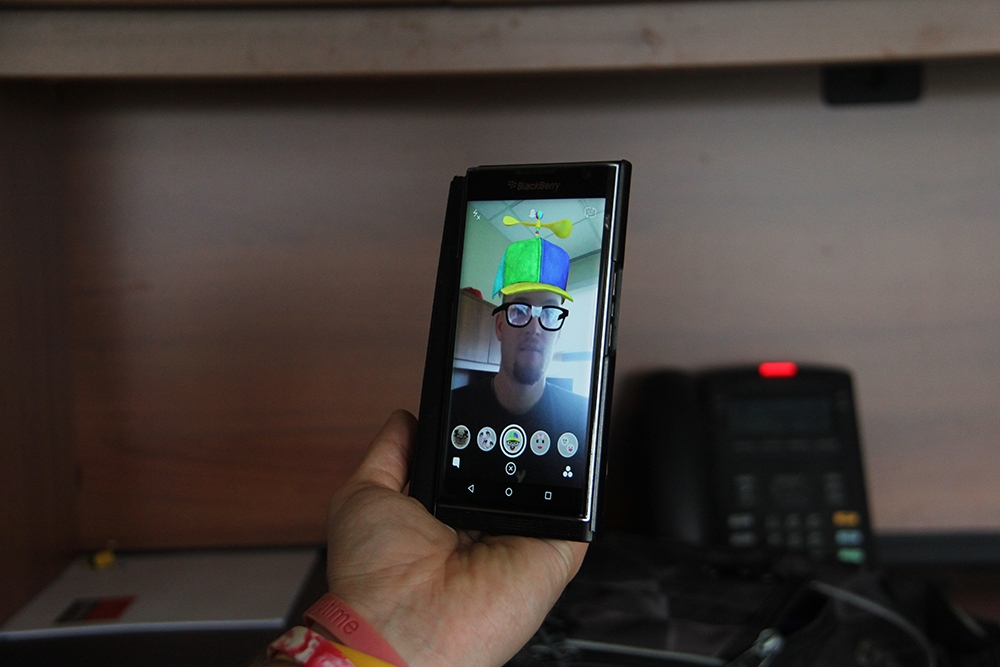Angelica Babiera | Contributor
Featured image: Students on campus have fun with Snapchat. | Amir Yazdanparast
At one point or another, all millennials craved their 15 minutes of fame, finding more ways to create content in a 10-second to five-minute timeframe. Facebook, Instagram and Twitter have become savvier with their short video features, recognizing how people share their stories, which allows brands to advertise their products while they make duck faces or raise their eyebrows. The social media site that has truly amped up their recording concept is Snapchat. Storming the world with its filtered, sticker-filled, 10-second recording session, Snapchat has garnered a cult following, with millennials obsessively recording their every movement to create the “Snapchat culture.”
The innate features of Snapchat promote this culture. As I gallivanted my way to Keele campus through my usual transit route, I took a quick Snap of my shoes to add to my Snapchat Story, and added a few more of my friends talking and joking around as the day went by. Every morning, I send out a good morning snap to my ‘streakers’—the friends I have a consistent streak of Snapping back and forth with. I feel compelled to keep up with a nonsense photo- and video-series of conversations between my friends and I.
But there is more to this phenomenon—it is used as an advertising platform for various campaigns and movements. From limited edition filters advertising coffee and make-up to sponsored stories from Vice and Cosmopolitan, Snapchat is moving away from its original intention of a sharing images that are short-lived and self-deleting. Cynthia Lam, second-year film production and political science student, is a traditional Snapchat user, taking silly photos and sharing them with friends without wasting precious memory space on her phone.
“I’m not particularly keen on the platform advertising themselves as a ‘news platform,’ if you will. I’m on Snapchat so I can have silly conversations with my friends, not to learn about what the top headline is for Daily Mail or Buzzfeed.”
This phenomenon isn’t just a local one. In fact, my relatives in the Philippines have discovered Snapchat and are continuously posting selfies of themselves with Snapchat filters on Facebook. Ultimately, Snapchat takes the most mundane parts of our day and turns them into something extraordinary and unique. Many users are unaware of the side effects it can have on our social capabilities and perception of life.
Last year, YFS hosted a concert at York that included rapper Big Sean, an optimal chance for Snapchat stories galore. Almost everyone at that concert had their phones out and Snapchatted the night away.
“Throughout the whole concert, everyone was Snapchatting, including me. It actually came to the point where I don’t even think people were enjoying themselves because everyone was too busy trying to get the perfect Snap to add to their stories so that it would be [entertaining] to others who would watch them,” reminisces Angela Brown, a second-year accounting student.
“As the show went on, I actually put down my phone and just started taking in the moment and thoroughly enjoy the music. After all, it was a free concert and I probably won’t be lucky enough to experience the luxury of first row again.”
There is a saying nowadays that goes like this: “Pics or it didn’t happen.” This is the epitome of everything I have just written about. It is ultimately the reason why we do it: we show everyone that our days and nights have been filled with so much fun and excitement because we do not want to seem square, boring or god forbid, basic.
Dennis Bayazitov, fourth-year professional writing student, says that he finds it fascinating how it confirms the effect technology has on society.
“Despite our smartphones empowering us to be the most social we have ever been, they have made it so that we are also the most anti-social we have ever been.”
Bayazitov points to the fact that with the existence of the internet, and by extension, the smartphone, information is abundant and social connectivity is at an all-time high.
“Yet, on a daily basis, we opt instead to input some of the most superfluous stimulus found online. Snapchat is no exception: in the same way that it is the most effective platform to immerse us in the present moment, it is also the most effective one at dis-involving us from it.”
Brown says that she regrets obsessing over her Snapchat activities during her concert experience. “It quickly became about me being seen at this concert. The perception that I was enjoying myself, which perhaps made those who didn’t go or couldn’t go feel envious.”
Snapchat recently added a new feature to their app called ‘Snapchat Memories’ where people can save their Snaps within the app and upload content from their camera roll into their Story. This changes the nature of Snapchat: before, the app was used candidly, prompting us to savour the moment exclusively through the app. Instead, we can relive and relive moments well after they occur.
It’s easier to remember the concert because we have the photos and videos stored. We can watch it over and over again. There’s only 10 seconds to show everyone how fun our lives are; 10 seconds to remember a concert; 10 seconds to showcase our perfection; 10 seconds to please our “friends.” What happens during the other 86,390 seconds of the day? If we could just put Snapchat and all of the social media sites on a diet, we could perhaps enjoy concerts, hangouts, vacations and our lives more. It’s just a matter of putting down our phones and focusing on the present.


